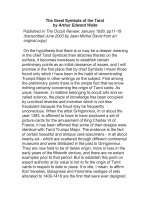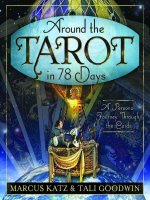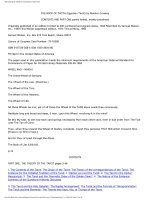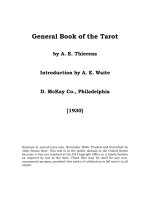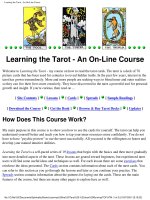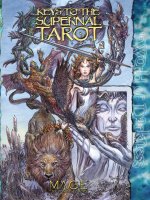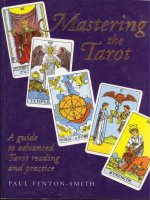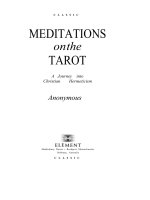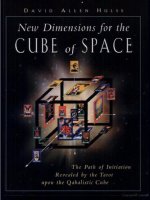Hướng dẫn bói bài Tarot The 23rd trump
Bạn đang xem bản rút gọn của tài liệu. Xem và tải ngay bản đầy đủ của tài liệu tại đây (318.73 KB, 13 trang )
Copyright Robert M. Place 2000
The Path of Dreams:
My involvement with the Tarot began with a dream, and since that
night, dreams, visions, and synchronicity have guided me deeper
and deeper into its mysteries.
When I began experimenting with the cards, I resolved not to read
any books on the Tarot. I wanted to communicate with the images
unhindered by preconceptions. The Tarot taught me a great deal
directly, but it also developed a hunger in me for more information. I
wanted to understand its history and the philosophy that led to its
creation. Eventually, I realized that to unlock its secrets further I had
to gather more information. I began reading everything that I could
find on the Tarot, Gnosticism, alchemy, and related subjects. Every
table in my studio, at that time in my western New Jersey home,
was soon covered with stacks of books reaching toward the ceiling,
and I filled a large hardbound book with charts, lists, and notes.
By 1987, my reading had become noticeably excessive to my wife
and friends - they seemed to be worried about me. I intuitively knew
that I was on to something, but I was unable to explain what it was.
One afternoon I was sitting in the living room reading when a
commentator on the radio began talking about the Harmonic
Convergence. Talk of this phenomenon had been peppering the
airwaves for a few weeks, but I thought of it as "just another newage curiosity." However, this time it was different, the commentator
said that, during this period of spiritual transformation, sensitive
individuals all over the Earth would be experiencing a flood of
information on spiritual subjects. Finally, someone had an
explanation for what was happening to me, this intensity was a
product of the time, in some way the "Soul of the World" demanded
it.
Shortly after August 16th - the day of the
Convergence - I was reading a book on
alchemy and became fascinated by a mandala
like symbol representing the Philosopher's
Stone, a substance of pure spirit that is the
goal of the alchemical quest. The oval design
depicted a heart in the center of a cross with
images of the four elements assigned to each
quarter. A twisted thorn covered vine more
closely encircled the heart. From the top of the
heart a rose bud sprouted and five drops of
blood were on its front.
In a flash, I realized that the
symbolism in the design was
interchangeable with that of the
World card in the Tarot of
Marseilles. The heart, of course,
was a reference to the "Sacred
Heart" of Christ. That it was in
the center of the four elements
was a symbolic way of stating
that it was the fifth element, the
spirit that holds together the
other four and creates the world
(the alchemists call this the
"quinta essentia" the origin of
the English word quintessence).
This is the spiritual substance
that the Philosopher's Stone is
made of. It can be symbolized by
Christ or, as in this case, by his
heart. The heart is also a symbol
of the soul and this alchemical
fifth element is more commonly
referred to as the "World Soul," or "Anima Mundi," symbolized by a
nude female. The nude on the World card is dancing in the center of
four creatures, the lion, the bull, the eagle, and the man, who
represent the four evangelists of the Christian Gospels. Through
their astrological association to the four fixed signs of the zodiac,
they are equated to the four elements. Putting her in the center of
the elements turns the layout into a standard symbol, called a
quincunx, an arrangement of five elements with one at each corner
and the fifth in the center representing the sacred axis. This
arrangement clearly states that she is the Hermetic fifth element,
the "Anima Mundi," the sacred axis of the world and the goddess
sought after by the alchemists.
This realization was like a key opening a lock in my head. I sat
mesmerized, as images flashed through my mind. It became
obvious that the Tarot trumps are alchemical, and that the series of
trumps - particularly in the Tarot of Marseilles - outlines the
alchemical Opus or Great Work, the search for the Philosopher's
Stone. This insight happened in seconds, but it began a seven-year
journey that led me to design and write The Alchemical Tarot.
Synchronicity was my guide on this journey, and it was synchronicity
that led me to write my first article on The Alchemical Tarot for the
Fall 1989 issue of Gnosis magazine. In turn, this article introduced
my to Rosemary Ellen Guiley, who asked me to write an article for
her book The Mystical Tarot. Later we teamed up to write the book
for The Alchemical Tarot, and it was Rosemary who introduced me to
our publisher, Thorsons, of London.
The Man with the Triangular Aura:
Although my creation of The Alchemical
Tarot was guided by my visions
throughout the work, after it was
complete and in print, it was Rosemary's
vision that led me to a deeper
understanding. One night Rosemary
awoke to find a man with a long white
beard and ancient clothing standing at
the foot of her bed. He had a triangular
aura about his head, and he was holding
an oversized Tarot card. Rosemary
recognized him as Hermes Trismegistus,
the first alchemist. The card he was
holding was labeled Truth, and it
depicted a pyramid in the air. The
pyramid consisted of seven layers; four
were made of solid stone; and dispersed
between the stone layers there were
three of air. From the top, a flame pointed to the heavens. Hermes
told her that this card was the 23rd trump (which, of course, is
labeled number 22). Rosemary described the vision to me and asked
me to illustrate it. A black and white version accompanies this
article.
From the beginning, I saw in the image the seven-fold latter of
ascent that the ancients related to the original seven planets and
the alchemists to the seven metals. In addition, I found a related
alchemical image of the philosopher's stone depicted as a triangular
mountain with a flame at the top. However, neither of us fully
understood the image at first. It has become a door that leads into
the Western Mystical tradition and its relationship to the Tarot. Each
of us has followed the trail in our own way. These are some of the
things that the image has taught me.
The Seven Fold Journey:
In the Classical world, a group of mystical philosophers, living in
Alexandria, wrote a series of texts of such profound wisdom that it
seemed to them that it was really the work of a god and that they
were only channels for this information. They did not sign their
names to this work but instead gave the credit to Hermes
Trismegistus, the thrice-great god. By the Third Century, the
philosopher called Plotinus married this mystical quest with the work
of Plato. This synthesis was later called Neoplatonism.
Hermetic and Neoplatonic philosophy permeated the Renaissance,
and they were encapsulated in the Tarot. These philosophies teach
that the spirit, the One, is beyond comprehension and can only
create the world through a series of stages or emanations. Plotinus
called the first emanation, after the One, "Nous." This is
synonymous with Plato's world of archetypes or forms, the ideas or
thoughts of the universe. These thoughts are the patterns that
manifest in the physical world. Plotinus represented the next
emanation as the "World Soul" or "Anima Mundi." The Anima Mundi
is the living presence in the physical world, the way that Nous
animates the world.
Later Neoplationists believed that the
Anima Mundi entered the world of
matter by descending a ladder of
seven planets that had been
described in the philosophy of
Hermes. The word planet is derived
from the Greek word "planetai" which
means wanderer. To the Greeks, the
wanderers were the seven celestial
bodies, visible to the naked eye,
which appeared to move
independently from the
constellations. They included the Sun,
the Moon, Mercury, Venus, Mars,
Jupiter, and Saturn. The ancients
believed that the Earth was in the
center of the Cosmos and that the
seven planets circled the Earth. Each
orbit was thought of as a crystal
sphere, one nesting inside the next
with the Earth in the center. Encasing
the outer most crystal was the sphere
of the constellations and beyond that was the home of the spirit.
Every living being is animated by the soul and all soul comes from
the one World Soul. Each part of the one Soul has to make this
journey through the seven soul centers of the cosmos, the planets.
Each planet clothes the soul in qualities - Later called the seven
virtues and seven vices - as it becomes a living individual. These
soul centers are echoed within our bodies as the seven centers
commonly called by their Sanskrit name, Chakras. The journey of
the soul can also be conceived of as a journey through this inner
space. The astrological natal chart is designed to map this process.
However, for the mystic the process must be reversed. In a trance
state the mystic ascends this seven runged ladder and lets go of
each quality, until union with the soul can be achieved. This state is
called gnosis, the wisdom of the experience of the spirit. This same
soul journey is the object of the alchemical "Great Work" or "Opus,"
and this is the story told by the Tarot Trumps.
If we view the Tarot trumps as this journey back to the soul, we
would expect to see an image of the World Soul on the last trump,
numbered 21, and as I explained in the beginning, that is exactly
what the last trump illustrates. To go beyond this trump is to ascend
to the next emanation, Nous. This is what is depicted on the card in
Rosemary's vision, Nous, the unchanging "Truth", or pattern behind
the world of matter, the world of constant change.
The Tetractys:
Like all true symbols, the Twenty-Third Trump
is multifaceted. It contains the pattern of the
mystical ascent, a pattern that is expressed
in the entire Tarot, but it includes all aspects
of this pattern in one image. Although it is a
pyramid, it also relates the Pythagorean
symbol called the Tetractys.
Pythagoras is well known as an ancient
Greek mathematician and the first person to
call himself a philosopher, which means a
lover of wisdom. He lived in the 6th Century
BCE, the same time that the city of
Marseilles was founded, and the time that Buddha was alive in India.
In many ways, his teaching paralleled that of Buddha. Pythagoras
taught that life is an endless series of reincarnations until we purify
ourselves and return to the One. For purification, Pythagoras
recommended a moral behavior based on the four Cardinal Virtues;
a vegetarian diet and healthful life-style; and contemplation of the
numerical abstract harmonies that underlie all physical reality - to
describe this he coined the word Cosmos. The symbol that the
Pythagoreans devised to represent this numerical intelligence of the
universe consisted of a triangular arraignment of ten dots
(considered the perfect number) with one at the top, two on the
second layer, three on the third, and four at the base. This symbol
was called the Tetractys, and the Pythagoreans considered it sacred.
We can see the similarity between the Tetractys and the pyramid on
the twenty-third trump. The dots are like the stones in the pyramid
that emanate from the One to the four-fold square of the base.
Between these physical layers, are the unseen spiritual layers that
permeate all of reality. Together they form the seven stages of
assent.
The physical layers describe the geometric progression of the
material world. The top depicts the point, a theoretical beginning
with no dimension. The second layer has two points, which describe
a line. Next are three points, which are necessary to form the first
polygon, the triangle. The base has four points, which brings us to
three-dimensional reality and allows us to form the first polyhedron,
the tetrahedron. This same progression is described in the famous
alchemical quote attributed to Maria Prophetissa,
Out of the One comes the Two, out of the Two comes Three, and
from the Third come One as the Fourth.
If we follow this progression backward, it leads us from physical
reality to it origin in the One, the Spirit.
The three immaterial layers in the Tetractys and in Hermes' pyramid
symbolized to the Pythagoreans the relationship between numbers.
These are called ratios. The One contains all relationship within
itself, and therefore, is beyond ratio. The first ratio is between the
one and the two, written as 1:2. Between the layers in the Tetractys,
we can also find the ratios 2:3 and 3:4. Pythagoras found that these
ratios described the vibrations of the most important points on the
musical scale; 1:2 is the whole note; 2"3 is the perfect 5th; and 3:4
is the perfect 4th. These three notes are harmonious realities that
underlie all music in any culture.
To fill out the scale Pythagoras devised four other notes and created
our familiar Western diatonic scale. Pythagoras believed that the
seven notes of the scale captured the sound that the seven planets
made as they traveled through the aither in their orbits. By tuning
his seven stringed lyre to this "music of the spheres," he could use it
to bring the corresponding soul centers in the human body into
balance and health.
The four layers in the Tetractys can also be used to describe the
relationships between the ratios. These are called proportions and
they show us the evolution of consciousness back to unity. At the
base we have a proportion envolving four qualities, described as a is
to b as c is to d. This is written a:b :: c:d. The Pythagoreans called
this discontinuous Proportion. It describes the ability to observe
relationships and patterns in reality - the beginning of intelligence.
Next, is continuous proportion, evolving three qualities and written
as a:b :: b:c. This is a higher state of the perception of relationship in
which the initiate begins to see the interdependence of all things. As
we progress we come to a relationship of two qualities, called the
golden relationship, in which a is to b as b is to a+b. This is a
relationship we can find in growth patterns in plants and animals
and throughout the proportions of the human body such as the
height of our navel in relationship our overall height. It represents
the appreciation of the duel forces of feminine and masculine or
love and strife at work in all processes and symbolizes the mystical
state approaching unity. In the final state of Oneness, all relationship
is dissolved in unity.
The following quote is attributed to Pythagoras:
There is a triple world, for Hierarchical Order always manifests itself
in three. The world simple, the world hieroglyphic, the world
symbolic; or the world that expresses, the world that conceals, the
world that signifies. All hieratic intelligence is in the perfect
knowledge of those three degrees.
Three Stages:
We see these same three stages in all myth, visions, and systems
that describe the process back to the One. Pythagoras illustrated
these stages in his story describing three different types of men who
come to a fair. The first comes to sell his wares and sees the fair as
an opportunity for profit. He is dominated by the concerns of the
first three soul centers, from the sacrum to the navel. The virtue
that he is developing is Temperance. The second is heroic, he comes
to compete in the games and win glory. This man is dominated by
the soul center of the heart, and is developing the virtue Strength or
Courage, a word that is derived from the Latin root "cor" meaning
heart. The third man comes to the fair to observe and contemplate;
he is the one Pythagoras describes as a philosopher. His concerns
are of the higher three soul centers from the throat to the crown,
and his virtue is prudence. This man is on the golden path, and his
path leads to the union with the One.
This same pattern is the theme underlying Plato's masterpiece, The
Republic. While describing the perfect society, Plato also describes
the stages necessary for the development of the philosopher king,
the ruler of his utopia. To become a citizen of the Republic one must
develop the virtue Temperance, a balance of the desires achieved
through the study of music. These people become the workers that
form most of the population. From this pool, certain people will be
able to develop the virtue Strength through the study of gymnastics
and rise to the level of warrior protectors. From this elite group,
some will develop the virtue of Prudence or Wisdom through the
study of math. These men and women will become the philosophers
and leaders. From this group one, who is equated to gold, will
achieve union with the will of Heaven and become the philosopher
king, the embodiment of the virtue Justice.
This same pattern can be seen in the story of Christ as expressed in
the mysteries of the rosary. The five Joyful Mysteries relate to the
first stage, the development of peace and prosperity in the physical
world. These mysteries are concerned with divine being embodied in
the child who is Jesus. The second group of five is called the
Sorrowful Mysteries. They relate to Christ's heroic sacrifice that
leads to the Crucifixion. The last five are the Glorious Mysteries,
which describe Christ's Resurrection and Assumption.
The influential, 12th century, visionary monk, Joachim de Fiore, saw
this pattern as describing the evolution of all humanity. In his grand
vision, he related all of human history with the three aspects of the
Holy Trinity. In the first age, the Age of the Father, the physical world
was created, the law was given and the Old Testament written. In
the Age of the Son, Christ was born and made his heroic sacrifice to
save the world; the New Testament was written and the Church
began. In the coming Age of the Holy Spirit, the Church will be
dissolved. It will be the golden age that Christ promised when love
will rule and individuals will communicate directly with god.
The Trumps:
This pattern is archetypal. It can be found in all cultures. The Jungian
scholar, Joseph Campbell, called it the Hero's journey. In the Tarot, it
is found in the trump cards.
In the game of Tarot, the Fool is not a trump proper he is a wild card
of no value that can fit in anywhere in the sequence. In modern
decks he is sometimes numbered zero, but the antique Tarot decks
are numbered with Roman numerals and there is no zero in Roman
numerals - he is simply a card without a number. He can be thought
of as taking the Fool's journey, the hero's quest. There are 21
numbered trumps which can be neatly divided into three groups of
the mystical number seven - Joachim also divided each of his three
ages into seven stages. These can be thought of as three acts.
On the first numbered Trump, the Bateleur,
we can find dice on his table. This is true of
most early printed decks from Italy or France.
Dice were an ancient tool for divination as
well as gambling, and this use of
combinations of numbers can be related to
Pythagorean mysticism. There are 21 possible
combinations of the throws of two dice, and
this number represents all the possible
divinatory solutions that two dice can give. In
the Renaissance, these 21 possibilities have
been represented as 21 allegorical figures
related to the Tarot. Dice are designed so that
the numbers on alternate sides of the die
always add up to the mystical seven. On the Bateleur of the
restored Tarot of Marseilles, published by Philippe Camoin of France.
we can see that his table has three dice displayed so that the three
sides facing us on each die add up the seven. The Bateleur initiates
the sequence of trumps; his three dice are outlining the series like a
table of contents. The trumps can be thought of as a three act play
each compose of seven cards
The first act, which depicts couples triumphed by love, is the Joyful;
the second act dominated by images of time mortality and suffering
is the Sorrowful; and the third act with its celestial ascent to the
Soul of the World is the Glorious. These three acts represent the
mystical ascent of the spirit immersed in the physical world, the
world of the four elements, four directions, and four seasons
represented by the other four suits in the Tarot. This in turn is the
structure of the Hermes' pyramid with its three immaterial layers,
the three acts, immersed in the four physical layers, the four suits.
This same three to four relationship can be seen in each of the
seven trump cards in each act. In the first act, there are four ruling
figures that are paired into two couples. These figures relate to the
four-fold physical world. Around them are three other cards that
depict the action of the first act. The Bateleur introduces the play
and begins the action. The Lovers card in the oldest decks simply
show a marriage or a betrothal and clearly indicates the triumph of
Love over the four-fold world. In the restored Tarot of Marseilles, this
card depicts a man choosing between a life of study, the woman
with the laurel wreath, and one of
sensuality, the woman with the wreath of
flowers. We can find this same image on
other French decks dating from the 17th
century. This is the decision that every
true philosopher has to face - this image
can be traced to the Pythagorean
allegory which describes the Greek letter
upsilon as representing two paths, one
easy but leading to ruin and one difficult
but leading to mastery. The final card,
the Chariot, shows that our hero has
resolved to take the journey to the next
level, the path of that takes the sorrows of the world head on.
The second act contains three cards that represent the human
mortal condition - the suffering to which all life leads. They are the
Hermit, the Hanged Man, and Death, and they symbolize old age,
suffering and death - the same three sights that Buddha had to
confront to find his motivation for his mystical quest. Interspersed
with this group are four cards representing the four Cardinal Virtues
that were extolled by the Classical writers. Three of the four are
clearly labeled as Justice, Strength, and Temperance. Occultists,
knowing that there should be four, have tried to turn the Hanged
Man into Prudence. However, to see Prudence we have to
understand the allegory. The virtues were first called cardinal by St.
Ambrose, the fourth century bishop of Milan and one of the four
"Doctors of the Church." This was part of his effort to Christianize
Greek philosophy. The word cardinal is derived from the Latin root
"cardo" which refers to the axis of a wheel. Cardinal means that
which turns the wheel. Originally, this referred to the four directions
and the four constellations of the seasonal changes, which turned
the wheel of time and space. The wheel of time and space was
commonly depicted as a circle containing the signs of the zodiac
and the ancients believed that it was controlled by Fortuna, or as
Plato called her Necessity. Fortuna is the embodiment of chance or
fate. St. Ambrose described the virtues as cardinal to indicate that it
was virtue that moved the wheel of time and space and not Fortuna.
In other words, through self-control, courage, and understanding we
can take the reigns away from fate and steer our lives ourselves.
This insight is Wisdom or Prudence and it is exactly what is
illustrated on the Tarot of Marseilles' Wheel. Here we see the wheel
of fate or time with three foolish creatures traveling around it. They
represent the three follies that cause the three aspects of suffering
that are placed in this second act. Notice that in the Tarot of
Marseilles the Cardinal Virtues are in the opposite order from the
way they were presented by Pythagoras and Plato. The Virtues are
moving against time and suffering. The symbol of the wheel is
possibly derived from the Pythagorean image of the wheel of
reincarnation. On the Tibetan Buddhist image of the wheel of
rebirth, we can also find in its center three creatures symbolizing the
folly that ties us to the material world. In this light, the virtues are
leading us to the end of mortality - the immortality of mystical
union.
In modern occult literature, the figure on the top of the wheel is
sometimes interpreted as a sphinx. This interpretation is in keeping
with the multifaceted symbolism of the Wheel. A sphinx is
commonly considered a symbol of wisdom or prudence. The most
famous Classical example is the sphinx in the myth of Oedipus, who
delivers the riddle, "What walks on four legs in the morning, on two
at midday, and on three in the evening?" The answer, of course, is
man who over time, at three different ages, crawls, walks, and walks
with a cane. The image of the sphinx is in keeping with the
symbolism of the wheel of time and the sorrowful second act.
The last act starts with two cards that can be described as bad and
ends with two that can be described as good. They are
complements of each other. In the middle are the three celestial
figures the Star, the Moon, and the Sun. We start the act with the
Devil in charge. The Tower breaks this power - What was crowned is
toppled. The Judgement allows the physical to ascend to the
spiritual, and the final card shows the attainment of the Good, the
Soul. The transition is accomplished by the ascent through the
seven planets depicted on the Star card as the seven stars leading
to the eighth sphere represented by the large star in the center. This
configuration is introduced by a nude representing truth and beauty.
The Moon and Sun, although part of this group, are highlighted on
separate cards because they also represent the feminine and
masculine forces that form the golden relationship.
Like all true philosophical quests, the cards have delivered us to the
mother of our soul. From there, we can ascend to Nous, who shows
us the entire journey in one eloquent symbol, and presents us with
the final assent.
Saint Sophia
all art, except for the Tetractys and the Bateletur,爄 s copyrighted to
燫 obert M. Place
Schedule a
Tarot Reading
Back to Introduction
Back to Menu
